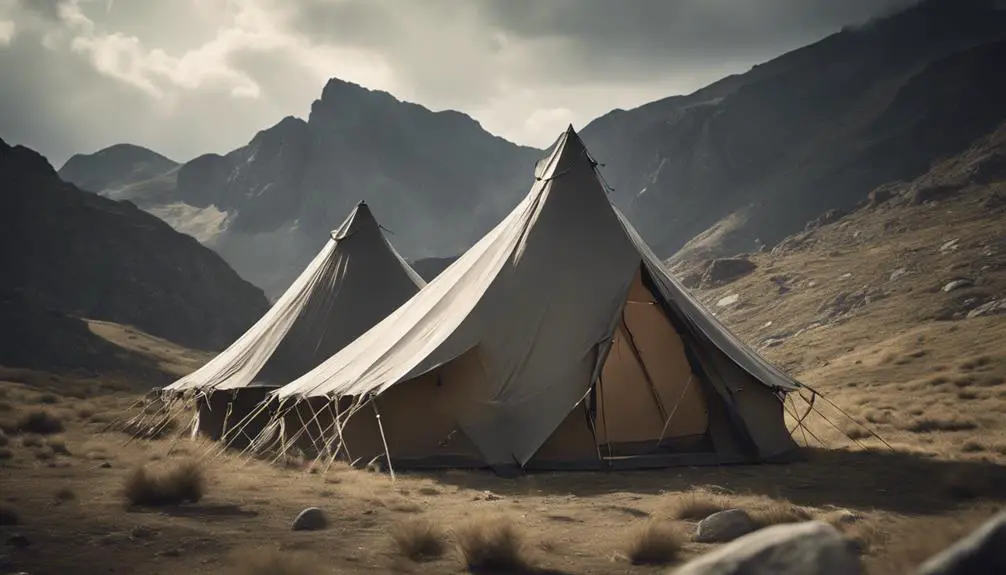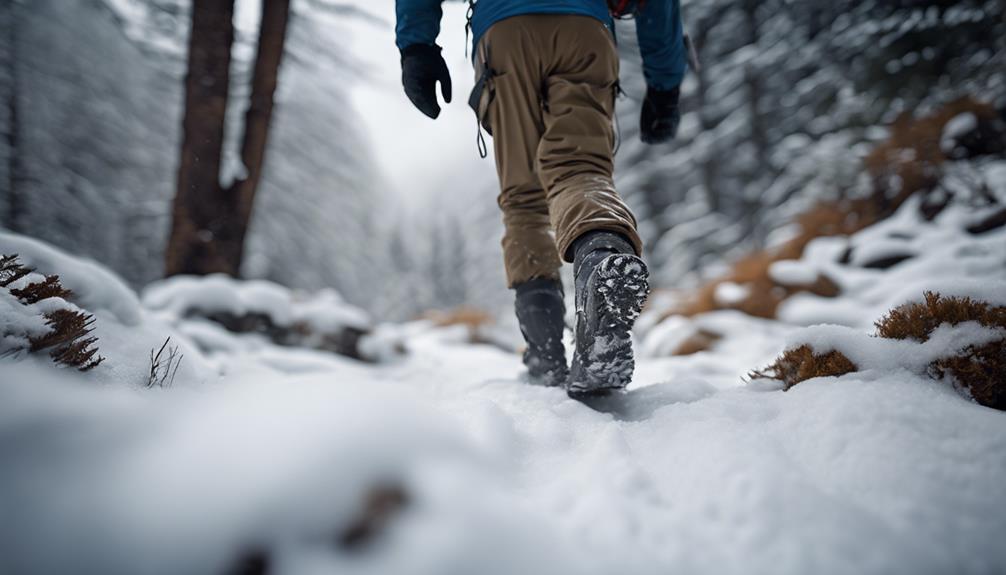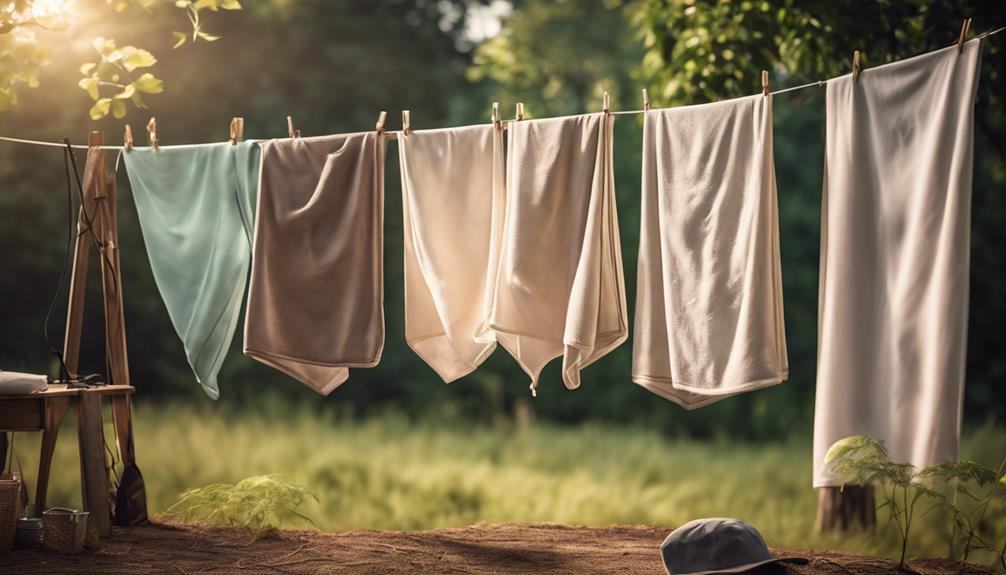
When you're out on windy hikes, picking the right tent stakes is crucial for keeping your shelter secure. Y-stakes, known for their three-sided shape, provide excellent grip to keep your tent in place.
On the other hand, V-stakes work best in sandy or loose soil conditions. If you're dealing with soft ground and strong winds, spiral stakes with their corkscrew design are your best bet.
It's essential to consider key features such as material strength, shape, length, weight, and versatility when choosing tent stakes. Materials like titanium, aluminum, and carbon fiber strike a good balance between strength and weight, ensuring durability without adding unnecessary bulk to your pack.
Brands like MSR Groundhog and Vargo Titanium offer reliable options for your outdoor adventures.
Proper installation of your tent stakes is equally important in maximizing security. Angling the stakes at 45 degrees into the ground can significantly enhance stability, especially in windy conditions.
By understanding these factors and choosing the right stakes for your specific needs, you can ensure that your tent remains firmly anchored, providing you with a safe and comfortable shelter during your outdoor excursions.
Types of Tent Stakes
There are a few different types of tent stakes that can really make a difference when you're setting up camp, especially in windy conditions.
Y-stakes are great for windy environments because of their three-sided shape, giving them excellent grip on various surfaces.
V-stakes, in the shape of a V, are lightweight and work well in sandy or loose soil.
Spiral stakes, with their corkscrew design, are perfect for soft ground and can withstand strong winds without budging.
Each stake type has its own strengths, so picking the right one is key to keeping your tent secure and cozy, no matter the weather.
Key Features to Consider
When you're looking at tent stakes for those blustery hikes, it's crucial to consider key features that can make a difference in keeping your tent secure. Factors like material strength, shape, length, and weight play a significant role in how well your stakes handle windy conditions and maintain durability.
First off, Material Strength is key. Look for stakes crafted from high-tensile materials that can withstand bending and breaking, ensuring they stand up to strong winds without giving in.
Next, think about Shape and Length. Stakes with a Y-shape or V-shape offer better grip and penetration, especially in softer or sandier ground where traditional stakes might struggle.
And don't forget about Weight and Versatility. Opt for lightweight stakes to lighten your load when backpacking, and choose designs that can adapt to different types of terrain for added convenience.
Best Materials for Stakes
Choosing the best materials for tent stakes is crucial for ensuring they can handle windy hikes and challenging terrains. Titanium stakes are top-notch with their excellent strength-to-weight ratio, perfect for those wanting durability without added weight.
Aluminum stakes are a popular choice due to their balance of strength, weight, and affordability, but they might bend under extreme pressure. On the other hand, steel stakes, although heavier, offer unmatched durability and are less prone to warping or breaking.
Carbon fiber stakes are known for their lightweight and high tensile strength, albeit at a higher cost. Each material has its unique benefits, so picking the right one depends on your hiking conditions and preferences.
Top Brands for Windy Conditions
If you're looking for tent stakes that can handle windy conditions like a champ, there are a few top brands worth considering. These brands have earned a reputation for providing sturdy performance and stability when the winds pick up. Here are three brands that excel in this department:
- MSR Groundhog Stakes: With their innovative Y-beam design, MSR Groundhog Stakes are a popular choice for hikers facing various soil types. These stakes offer exceptional holding power, making them a reliable option for windy adventures.
- REI Snow and Sand Stakes: Designed with a wider profile, REI Snow and Sand Stakes are built to anchor securely in loose soils. These heavy-duty stakes are perfect for challenging environments where stability is key.
- Vargo Titanium Tent Stakes: For those seeking a balance of durability and lightweight design, Vargo Titanium Tent Stakes are a top pick. These stakes are crafted to withstand strong winds without adding unnecessary weight, making them ideal for extended treks in unpredictable weather.
Make sure to choose the right tent stakes to keep your shelter secure and stable, even when the wind decides to show its strength.
Tips for Proper Installation
When setting up your tent stakes for optimal stability in windy conditions, it's crucial to nail down the right installation techniques. Start by angling your stakes at about 45 degrees away from your tent to ensure they grip the ground effectively.
Tailor your stake choice to the soil type; longer stakes work best for sandy or loose soil, while shorter, sturdier stakes are ideal for rocky or compact soil.
When hammering in the stakes, use a gentle tapping motion to prevent any damage. If you're dealing with tough soil, opt for a mallet over a rock to keep your stakes intact.
Frequently Asked Questions
How Do I Store Tent Stakes to Prevent Damage?
Storing your tent stakes properly is essential to keep them in good condition for future camping trips. To prevent damage, it's best to invest in a sturdy, lightweight, and portable container. This will not only protect your stakes but also make them easy to transport. Ensuring they are stored securely will help maintain their longevity and functionality.
When choosing a container for your tent stakes, opt for a multi-purpose option that can serve other storage needs as well. This way, you can maximize its use and reduce the need for multiple containers. Consider eco-friendly alternatives that align with your values and promote sustainability. By making conscious choices in your storage solutions, you can contribute positively to the environment.
Can I Use the Same Stakes for Different Types of Terrain?
Absolutely, you can definitely use the same stakes for different types of terrain. However, it's essential to consider the durability of the stakes and their compatibility with various terrains to ensure they provide a secure anchor and avoid any potential damage. This way, you can camp with confidence knowing your equipment is reliable and well-suited for any type of terrain you encounter.
Are There Eco-Friendly Options for Tent Stakes?
Absolutely, you can definitely find eco-friendly options for tent stakes! Opting for biodegradable alternatives not only supports sustainability but also ensures that your camping gear leaves minimal impact on the environment. Additionally, consider choosing tent stakes made from upcycled materials. These stakes are not only durable but also contribute to reducing waste by giving new life to old materials.
How Many Stakes Should I Carry for a Typical Hike?
To ensure your tent stays sturdy in the face of unpredictable weather, it's a good idea to have at least eight stakes handy. By placing them strategically, you can distribute the weight evenly, boosting your tent's stability. This way, you can relax and enjoy your outdoor adventure without fretting over your tent's security.
What Are Some Common Mistakes to Avoid When Using Tent Stakes?
When setting up your tent, it's important to avoid some common mistakes with tent stakes. One of these mistakes is not placing the stakes at the right angle, which can lead to instability. Make sure to angle the stakes correctly to ensure a secure hold for your tent.
Another mistake to watch out for is improper tensioning of the stakes. If the tension is too loose, the tent may not be secure, while if it's too tight, it could damage the fabric. Finding the right balance in tension will provide stability and freedom for your outdoor adventures.
Conclusion
Choosing the right tent stakes is crucial for keeping your tent secure during windy hikes. You'll want to consider factors like the type of stake, the material it's made of, and the reputation of the brand.
Materials like aluminum, titanium, and steel are great choices due to their strength and durability. Properly installing the stakes will also help maximize stability, reducing the risk of your tent getting blown away in challenging weather conditions.
When it comes to selecting tent stakes, it's important to opt for materials known for their resilience. Aluminum, titanium, and steel stakes are highly recommended for their ability to withstand strong winds and harsh conditions. These materials offer the durability needed to keep your tent firmly anchored, giving you peace of mind during your outdoor adventures.
In addition to choosing the right materials, how you install your tent stakes plays a significant role in ensuring stability. Make sure to drive the stakes into the ground at a slight angle, pointing away from the tent. This technique helps increase the stakes' holding power, preventing them from pulling out in gusty winds.
By combining the right materials with proper installation methods, you can create a sturdy tent setup that can withstand even the most challenging weather conditions.
By carefully considering the type of stakes, materials, and installation techniques, you can enhance the stability of your tent and minimize the risk of it getting damaged or blown away in windy conditions. Aluminum, titanium, and steel stakes, when installed correctly, offer the strength and durability needed to secure your tent effectively. Prioritizing these factors will help you enjoy your outdoor experiences with confidence, knowing that your shelter is well-protected against the elements.
- Discover the 4 Must-Have Camping Tent Accessories for Spring 2025 - March 19, 2025
- Why Camping Is Bad - November 29, 2024
- Best Camping Knife - November 29, 2024






